Beyond The Tipping Point: Setting
the Stage for Weimar?
Metamorphosis in 2009/2010
London, UK - 23rd December 2008, 02:19 GMT
Dear ATCA Open & Philanthropia Friends
[Please note that the views presented by individual contributors
are not necessarily representative of the views of ATCA, which is neutral.
ATCA conducts collective Socratic dialogue on global opportunities and threats.]
Will the "zero interest rate policy" help the US
economy recover? Or will it make matters worse? In recent weeks the US Federal
Reserve has dramatically enlarged its role in the functioning of the financial
markets. It has even taken over the role that was the original purpose of
the Treasury's USD 700 billion Troubled Asset Relief Program (TARP). The
difference between a Fed bailout of troubled financial institutions and
a Treasury bailout is that central bank loans do not have the oversight
safeguards that US Congress imposed upon the TARP. The total of such emergency
Fed lending exceeded USD 2 trillion on November 6th. It had risen by an
astonishing 138 percent, or USD 1.23 trillion, in the 12 weeks since September
14th, when the central bank governors relaxed collateral standards to accept
securities that were not rated AAA. They did so knowing that on the following
day a dramatic shock to the financial system would occur.
On September 15th, Federal Reserve Chairman, Ben Bernanke, New York Federal
Reserve President, Tim Geithner -- the new Obama Treasury Secretary-designate
-- along with the Bush Administration led by Treasury Secretary, Henry Paulson,
agreed to let the fourth largest investment bank, Lehman Brothers, go bankrupt,
defaulting on billions of dollars worth of derivatives and other obligations
held by investors around the world. That event, as is now widely accepted,
triggered a global systemic financial panic as it was no longer clear to
anyone what standards the US Government was using to decide which institutions
were 'too big to fail' and which were not. Since that fateful decision,
the US Treasury Secretary has reversed his policies on bank bailouts repeatedly,
leaving markets confused as to whether he and the Bush Administration had
any coherent strategy for management of the continuing crises in credit
markets, or whether their actions simply represented improvisation in fighting
fires one at a time.
On November 7th, Bloomberg filed a law suit under the US Freedom of Information
Act (FOIA) requesting details about the terms of eleven new Federal Reserve
lending programmes created during the deepening financial crisis.
On December 8th, the Fed denied this request on the grounds that details
of its actions would reveal 'trade secrets' and 'commercial information'
about the recipients of its actions. Thus, the Fed has bluntly refused to
disclose the recipients of more than USD 2 trillion of emergency loans from
US taxpayers, and refused to reveal the assets the central bank is now accepting
as collateral. This has left markets uncertain as to what the Fed's ultimate
objective might be, or even whether there was any consistent strategy underlying
the Fed's continuous stream of innovative lending facilities and purchases
of asset backed securities. Questions are now being raised as to whether
the Fed's unprecedented expansion of the monetary base in recent weeks might
set the stage for a future Weimar-style hyperinflation in 2009/2010.
In response to the widening credit market crises and signs of deepening
recession, the US Fed is expanding what is technically called the Monetary
Base, defined as total bank reserves plus cash in circulation, the basis
for potential further high-powered bank lending into the economy. Since
the Lehman Brothers default, this money expansion rose dramatically by end
October at a year-on-year rate of growth of 38%. This has been without precedent
in the 95 year history of the Federal Reserve since its creation in 1913.
The previous high growth rate, according to Fed data, was 28% in September
1939, as the US was building up industry for the evolving war in Europe.
This leaves market analysts worried about whether the American economy is
confronted with deflation or inflation, or even worse, a period of deflation
soon followed by hyperinflation generated by the hyperactive expansion of
the monetary base and the Fed's balance sheet. In parallel, US government
borrowing has spiked -- up from an annualised rate of USD 310bn in the second
quarter of this year to an astonishing USD 2+ trillion at present and rising.
Both US fiscal and monetary policy now seem wildly expansionary, to an extent
never seen before. The present course of Fed policy seems likely to continue
at least until a new Administration takes office. At that time, President
Obama will have the opportunity to shape his own fiscal stimulus package
but also to appoint a number of new Governors of the Federal Reserve, whose
opinions could prove crucial in shaping the Fed's actions early next year.
Up until now, President-elect Obama has declared that he wants the US Congress
to enact a major fiscal stimulus package of a little less than USD 1 trillion.
He has not explained what he would hope the Fed might do in parallel with
his fiscal plans.
Whether the threat of deflation is converted into hyperinflation may thus
depend upon decisions taken in Washington, DC, in coming weeks. We already
have some insight into the potential dangers when we consider the case of
the Weimar Republic. In 1920, Germany experienced a deflationary collapse,
with the average citizen finding it harder and harder to get enough money
for necessities. Banks, short of money, could not honour cheques, and businesses
were strapped for cash to buy materials and meet payroll. Fearing a collapse
that would throw millions of workers out on the street, the German government
desperately printed money in an attempt to re-inflate the economy. During
this period, despite the government's money printing, the Reichmark actually
gained in value against foreign currencies, so that prices of imported goods
fell by some 50%. Eventually, as a result of the money supply's rapid expansion,
the nation's massive foreign debt, and shrinking economy, German citizens
lost all confidence in their currency, and the Weimar Republic experienced
one of the worst cases of hyperinflation in modern economic history in 1923/1924.
As a result, with no countries to competitively devalue against, even the
Weimar hyperinflation failed to achieve its goal, resulting only in the
worldwide slide into recession that culminated in competitive devaluations
in all countries to achieve the inflation against gold that was necessary
to start the recovery. [Reference ATCA: Bretton Woods II]
If we examine the US monetary base -- all paper dollars and coinage in existence
-- it took two centuries for the monetary base to go from USD 0+ to USD
800 billion, but in just the past 3-months it has nearly doubled -- growing
from around USD 800 billion to USD 1.5 trillion -- and by the time we look
closely again in 2009 it will probably have surpassed USD 2 trillion. That
is double the number of paper dollars in existence since last summer! Moreover,
until September 2008, the month of the Lehman Brothers collapse, the Federal
Reserve had held the expansion of the Monetary Base virtually flat. The
76% expansion has almost entirely taken place within the past three months,
which implies an annualised expansion rate of more than 300%.
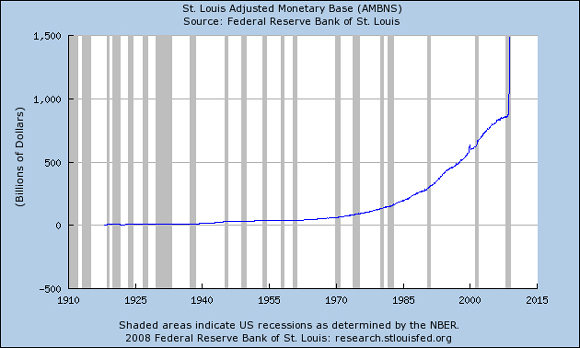
Despite this, banks continue to be unwilling to lend further.
As pointed out by the some of the top economists at the Federal Reserve
Bank of Minneapolis [Working Paper Number 666], it is not at all clear that
bank lending is the problem, as even the Federal Reserve Board's indicators
of bank lending show little or no significant decline. Hence, the US economy
is in a depression free-fall of a scale not seen since the 1930s. Banks
do not lend in part because under Basel-II -- Bank for International Settlements
(BIS) -- lending rules, they must set aside 8% of their capital against
the value of any new commercial loans. Yet the banks have no idea how much
of the mortgage and other troubled securities they own are likely to default
in the coming months, forcing them to raise huge new sums of capital to
remain solvent. It is far 'safer', they reason, to pass on their toxic waste
assets to the Fed in return for earning interest on the acquired Treasury
paper they now hold. Bank lending is risky in a depression. Banks are also
well aware that their off balance sheet exposure is far larger than their
on balance sheet positions. As Prof Joseph Mason pointed out in his recent
ATCA submission, the off balance sheet exposure of FDIC insured banks is
now an extraordinary multiple of 16 times their on balance sheet positions.
There can be little doubt that the off balance sheet positions are primarily
constituted of troubled assets, since if there were any high quality assets
in those structured vehicles they would have long since been brought back
onto the balance sheets of troubled banks.
American banks have exchanged USD 2 trillion of presumed toxic waste securities
consisting of Asset-Backed Securities in sub-prime mortgages, stocks and
other high-risk credits in exchange for Federal Reserve cash and US Treasury
bonds or other Government securities still rated AAA, ie, risk-free. The
result is that the Federal Reserve is holding some USD 2 trillion in largely
junk paper from the financial system. The banks benefiting from the Fed's
actions naturally oppose any release of information because that might signal
'weakness' and spur short-selling, selling or a run by depositors - whether
or not they are appropriate in doing so.
To replace wholesale deposits with retail deposits is a process that in
the best of times will take years, not weeks. Understandably, the Federal
Reserve does not want to discuss this. That is clearly also behind their
blunt refusal to reveal the nature of their USD 2 trillion assets acquired
from member banks and other financial institutions. Simply put, were the
Fed to reveal to the public precisely what 'collateral' they held from the
banks, the public would know the potential losses that the government may
take. Even though the Fed does not reveal the details, the very act of omission
is an implicit confession that there are more toxic assets hidden than they
would care to have revealed at this stage.
Making the situation even more drastic is the banking model used first by
US banks beginning in the late 1970s for raising deposits, namely the acquiring
of 'wholesale deposits' by borrowing from other banks on the overnight interbank
market. The collapse in confidence since the Lehman Brothers default is
so extreme that no bank dares trust any other bank enough to borrow. The
US Federal Deposit Insurance Corporation is currently considering an additional
regulatory tax on Brokered Deposits, placed in sound banks by knowledgeable
brokers, confusing liability risk with asset risk. That leaves only traditional
retail deposits from private and corporate savings or checking accounts.
On December 10th, in Congressional hearings by the House Financial Services
Committee, Representative David Scott, a Georgia Democrat, said Americans
had 'been bamboozled,' slang for defrauded. Several members of the US Congress
are now demanding more transparency from the Federal Reserve and US Treasury
on bailout lending. US Fed Chairman Ben Bernanke and Treasury Secretary
Henry Paulson said in September they would meet Congressional demands for
transparency in a USD 700 billion bailout of the banking system.
In early December the US Congress oversight agency, GAO, issued its first
mandated review of the lending of the US Treasury's USD 700 billion TARP
program (Troubled Asset Relief Program). The review noted that in 30 days
since the programme began, Henry Paulson's office had handed out USD 150
billion of taxpayer money to financial institutions with no effective accountability
of how the money is being used. It seems Henry Paulson's Treasury has indeed
thrown a giant 'tarp' over the entire taxpayer bailout.
The next chart is "Cash in Circulation". So far only a small amount
of all that extra currency has leaked out of the banking system and into
circulation. But one can assume that at some stage it will begin to do that
more excessively. When it does, it means that prices must rise to soak up
all that extra currency, like a sponge which soaks up liquidity. This could
be bad news for someone holding cash US dollars, but cause for celebration
for those holding physical assets such as houses, land or precious metal.
The two spikes are illustrative of the massive infusions of cash the Fed
has relied upon in righting recent recessions of 2001 and 2007/2008 (thus
far).
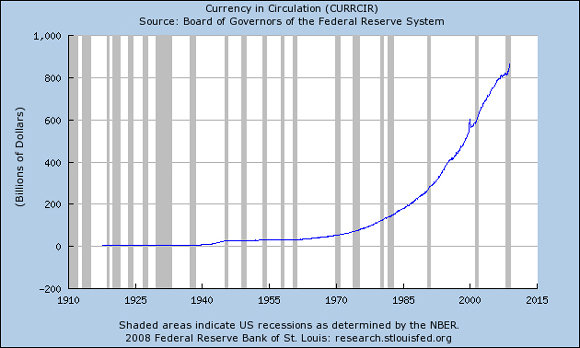
Here is a chart of how many dollars the banks have borrowed
from the US Federal Reserve through the end of last year (2007). Please
note the spike that indicates the banks had to borrow USD 8 billion from
the Federal Reserve during the Savings and Loan (S&L) Crisis of the
late 1980s.
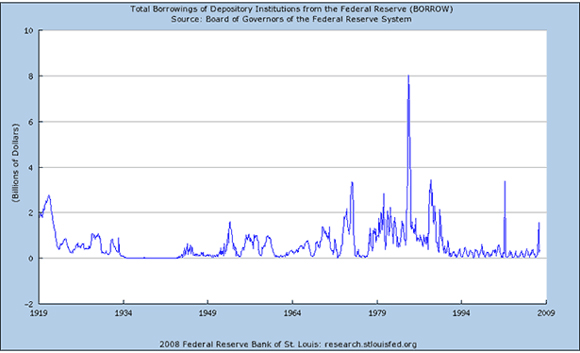
Here is the same chart, but ATCA RAW has now taken it out
to the beginning of November 2008. One cannot even see the USD 8 billion
S&L crisis peak anymore! In fact, the banks are approaching USD 800
billion in borrowings. This means that the central banking system already
perceives this crisis as being 100 times larger than the S&L crisis.
In terms of policy response, this is already about on par with that in the
Great Depression. For example, the Reconstruction Finance Corporation's
USD 50 billion (1937 dollars) in real dollar terms today, amounts to between
USD 600b and USD 7.5 trillion depending on inflator.
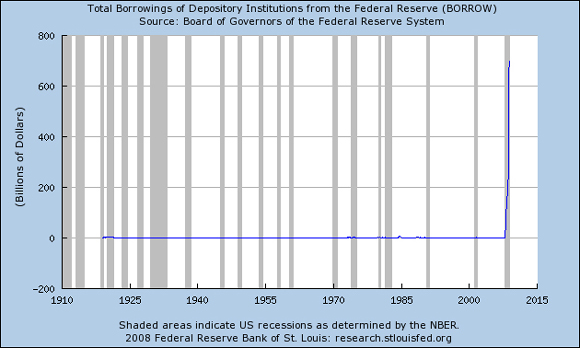
This next chart is Reserve Bank Credit. It is the total amount
the Federal Reserve has loaned out of its theoretically infinite check book,
ie, bank borrowing. This chart includes all the rest of the bailouts (at
least to the beginning of November 2008). This chart also rises to roughly
USD 800 billion by the end of 2007, but by the start of November 2008, it
has risen to USD 2.2 trillion.
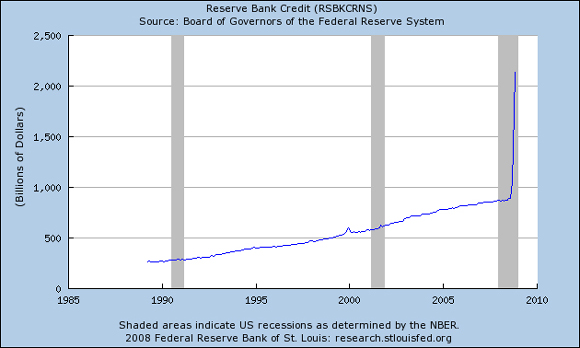
Finally, ATCA has a chart of "Excess Bank Reserves".
These are reserves in excess of the amount that the Federal Reserve requires
the banks to have. It looks almost identical to the chart of Bank Borrowings,
except for two small features; there is a tiny blip in 2001 and a small
bump around 1941. It would imply that the banks perceive this crisis to
be 50 times larger than 9/11 or even World War II.
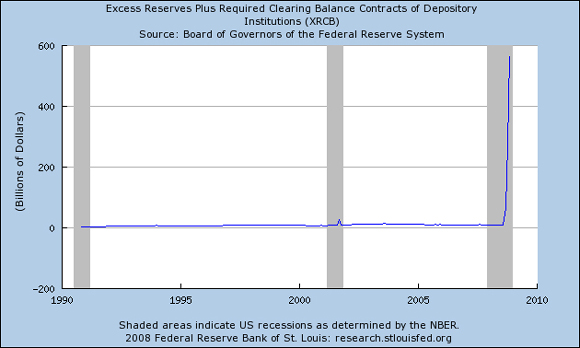
All graphs in this article have been sourced from the US Federal
Reserve Bank (of St Louis). These charts raise the question of whether in
a few years a chart of the price of physical assets like land and precious
metals including gold might look similar to these charts. In such a case,
would the chart of the purchasing power of the US dollar look like one of
these charts flipped upside-down?
Under the euphemism of "quantitative easing", the Fed appears
to be printing trillions of dollars, using them to buy up mortgage debt,
credit card debt and other junk securities the private sector does not want.
The Fed's actions are evidently designed to avert deflation. The question
must, however, be asked whether the Fed's current actions will inevitably
bring about a surge of Weimar Republic-style inflation. Is the Fed "lubricating"
the system, or is it flooding the engine of the US economy with so much
cash that the ultimate outcome will be a hyper-inflated recovery, characterised
by hyperinflation and anaemic economic growth?
The Fed's actions have driven the yield on the 30-year US bond down to 2.6
percent -- the lowest for 50 years. This Fed may be determined to maintain
such a low yield for a prolonged period, but in the event that the markets
ultimately become overwhelmed with the Fed's printing presses, the yield
could take off in the midst of an economic blood-bath. It may be asked whether
such low yields suggest the US Treasuries market could perhaps be moving
into bubble territory. The Fed has committed itself to buying long-term
US government debt in huge quantities. But, as America's liabilities rise
and the printing presses keep rolling, there will increasingly be risk that
the dollar will fall. If that were to happen, the argument for holding US
Treasuries would collapse! The danger is now rising that, in the near future,
the only net buyer of US Treasuries could be the Fed itself. Very serious
questions would then be asked about America's ability to service its debt.
Would foreign creditors remain passive in such a challenging situation?.
This scenario is alarming, but far from impossible. It is apparent that
the Fed believes it is fighting deflation. But its argument and modus operandi
raises questions. As measured by the pre-Clinton methodology, before the
politicians started messing with the numbers -- inflation stands at +4.5
percent. Is that inflation or deflation at present? Deflation is clearly
being used as a basis to print money in an effort to bury mistakes -- past
policy errors -- and bail out Wall Street. US regulators have undertaken
a massive policy of forbearance in recent years, and many banks need to
be closed. The inflationary stance is therefore currently being used to
patch over those shortcomings without really closing insolvent banks and
recapitalising others.
The Federal Reserve's actions since September suggest signs of panic. The
new money is not being 'sterilised' by offsetting actions by the Fed, a
highly unusual move suggesting a degree of desperation. Prior to September,
the Fed's infusions of money were sterilised, making the potential inflation
effect 'neutral.' This means once banks begin finally to lend again, perhaps
in a year or so, the lack of sterilisation will flood the US economy with
liquidity in the midst of a deflationary depression. At that point or perhaps
well before, depending upon the economic and monetary policies of other
governments around the world, the dollar could collapse as foreign holders
of US Treasury bonds and other assets run. Such a scenario would result
in a sharp appreciation in the euro and a crippling effect on exports in
Germany and elsewhere should the nations of the EU and other non-dollar
countries such as Russia, OPEC members and, above all, China not have arranged
a new zone of stabilisation apart from the dollar.
On December 15th, Bloomberg reported -- Dollar Staggers as US Unleashes
Cash Flood: "US policy makers are flooding the world with an
extra USD 8.5 trillion through 23 different plans designed to bail out the
financial system and pump up the economy."
In the present circumstances, with the government and the central bank taking
a growing role in the functioning of credit markets -- and even in the functioning
of industry -- it is not surprising that people in the Western world are
finding it difficult to trust their banks. Is money safe in a bank? If gut
feeling suggests "No", one might be right. Remember, we don't
have physical asset backed money in the bank, we only have a number on a
computer screen. This time around, there is no commitment to re-establish
the "Gold Standard" and no intent to even try to return to pre-crisis
parity, even if that could be judged as theoretically correct.
Right now, the US Federal Reserve, and the Western banking system in general
seem to be gearing up for an event the type of which we have never before
seen. ATCA RAW and the mi2g Intelligence Unit are of the view that the crisis
that will unfold over the next few years could potentially add up to the
biggest economic event in history. The scale of what has happened and will
happen may dwarf all other economic events combined. The Tulip mania of
1637, John Law's "Mississippi Scheme" of 1720, and the dotcom
bubble of 1999/2000 are all set to pale in comparison. Even the hyperinflation
in Weimar Germany in 1923/24 and the 1930s Great Depression which followed
the stock market crash in 1929 may be inappropriate comparisons.
The world faces the greatest financial and economic challenge in history
in coming months. The incoming Obama Administration may find itself with
a choice of literally nationalising the credit system to insure a flow of
credit to the real economy over the next 5 to 10 years, or to face an economic
Armageddon that will make the 1930s appear to be a milder event by comparison.
For the week ended December 6th, initial jobless claims in the US rose to
the highest level since November 1982. More than four million workers remained
on unemployment, also the most since 1982 and in November US companies cut
jobs at the fastest rate in 34 years. Some 1,900,000 US jobs have vanished
so far in 2008.
As a matter of relevance, 1982, for those with long memories, was the depth
of what was then called the Volcker Recession. Paul Volcker, a Chase Manhattan
alumnus of the Rockefeller family institution, had been brought down from
New York to apply his interest rate 'shock therapy' to the US economy in
order as he put it, 'to squeeze inflation out of the economy.' He squeezed
far more as the economy went into severe recession, and his high interest
rate policy detonated what came to be called the Third World Debt Crisis.
The same Paul Volcker has just been named by Barack Obama as Chairman-designate
of the newly formed President's Economic Recovery Advisory Board.
Virtually every time governments, and/or the banking system, abuse a fiat
paper currency enough to push it to a tipping point (such as in these charts),
the free market and the will of the public revalue gold and silver as well
as land to account for the excess currency that was created since the last
time they were revalued. But this time, for history to repeat, and for gold
to do what it did in 1980, 1934, and hundreds of times throughout history
going all the way back to ancient India, Greece and Rome, it will require
a gold price of over USD 10,000 per ounce from today's USD 800+. That is
if they stop printing US dollars today!
The present economic collapse across the United States is driven by the
collapse of the several trillion dollars market for high-risk sub-prime
and Alt-A home mortgages and other forms of securitised debt, superseded
by the eight bubbles outlined within ATCA. Fed Chairman Bernanke is on record
stating that the worst should be over by end of December, but there seems
little reason to make such a judgement. The same Bernanke stated in October
2005 that there was "no housing bubble to go bust." Moreover,
once the residential mortgage market blew up, he assured that the problem
would be "contained." So much for his predictive acuity. The widely-used
S&P Schiller-Case US National Home Price Index showed a 17% year-on-year
drop in the third quarter with a rising trend. On present estimates it could
take as long as another five to seven years to see US home prices reach
bottom. However, if hyperinflation should manifest, house prices will start
rising dramatically. In 2009 as interest rate resets on some USD 1 trillion
worth of Alt-A US home mortgages begin to kick in, the rate of home abandonments
and foreclosures could potentially explode. Little in any of the so-called
mortgage amelioration programmes offered to date reaches the vast majority
affected.
The definition of Depression was recently published, a term that was deliberately
dropped after World War II from the economic lexicon as an event not repeatable.
Since then all downturns have been termed 'recessions.' Per the US economic
authorities at the Commerce Department's Bureau of Economic Analysis and
at the National Bureau of Economic Research (NBER), as well as numerous
private sector economists, the more precise definitions of 'recession,'
'depression' and 'great depression' follow. The official NBER definition
of recession is, "Two or more consecutive quarters of contracting real
GDP, or measures of payroll employment and industrial production."
"A depression," is defined, "as a recession in which the
peak-to-bottom growth contraction is greater than 10% of the GDP."
"A Great Depression," is defined as, "one in which the peak-to-bottom
contraction exceeds 25% of GDP."
In the period from August 1929 until he left office in January 1934 President
Herbert Hoover oversaw a 43-month long contraction of the US economy of
33%. Is it conceivable that Barack Obama might break that record, and preside
over what historians might end up calling the Very Great Depression of 2008-2014?
What is needed is a radically new strategy to put virtually
the entire United States economy into some form of an emergency 'Chapter
11' bankruptcy reorganisation where banks take write-offs of up to 90% on
their toxic assets, that, in order to save the real economy for the American
population and the rest of the world. Paper money can be shredded easily.
Not human lives. In the process it might be time for the US Congress to
consider retaking the Federal Reserve into the Federal Government as the
Constitution originally specified, and make the entire process easier for
all.
The Risk of Sudden Collapse of All Capital-Based Pension Systems
The Fed's relentless effort to suppress long-term yields could generate
yet another crisis affecting the future years of the majority of the working
population. By April 2009, the general public will become aware of three
major destabilising processes beyond the scale, speed, severity and synchronicity
of the present global downturn, which are linked to the next leg of The
Great Unwind:
. Time Horizon: The full length and end-point of the crisis will become
more (and not less) elusive to determine;
. Unemployment: Major increase of unemployment in millions per month per
major G7 country and worldwide with attendant social unrest; and
. Sudden Collapse: The risk of sudden collapse of all capital-based pension
systems as the value of annuities and paper assets erodes.
Among the various consequences of the crisis for tens of millions of people
in the G7 -- US, Japan, EU-4, and Canada -- from the end of this year and
starting early in 2009, news about major losses on the part of the organisations
in charge of managing the financial assets that finance pension annuities
could multiply.
The OECD anticipates that pension funds have lost USD 4 trillion in 2008
already. In the Netherlands as well as in the United Kingdom, monitoring
organisations recently blew the whistle asking for an emergency contribution
reappraisal and a state intervention. In the United States, growing numbers
of announcements call for contribution increases and benefit reductions,
knowing that it is only in a few weeks time that most of these pension funds
will start calculating their total losses.
Most of the pension systems are still deluding themselves about their capacity
to build up their capital base again after the markets turn around. In March
2009, when pension fund managers, pensioners and governments will become
simultaneously aware of the fact that the crisis is there to last, that
it coincides with the baby-boomer generation's age of retirement and that
the markets will not resume their 2007 levels until many long years to come,
chaos will flood this sector and governments will reach the moment when
they may be compelled to nationalise all these funds. Surprisingly, Argentina,
which took this decision a few months ago already, may appear to have been
a pioneer!
Metamorphosis
Numerous Western government have been preparing their domestic security
systems precisely for the unfolding consequences of The Great Unwind projected
by April 2009, as the establishment expects backlash, ie, domestic violent
unrest when people become frustrated with the economic crisis and cross
the tipping point, much like what has happened in Greece. A whole range
of psychological factors are contributing to this tipping point: people
are starting to become aware in Iceland, the Euroland (especially Greece,
Ireland, Portugal and Spain), UK, America and Asia that this trans-national
crisis has escaped from the control of every public authority, whether national
or international; that it is severely affecting all regions of the world,
even if some are affected more than others; that it is directly hitting
hundreds of millions of people in the "developed" and "emerging"
world; and that it is only worsening as its consequences reveal themselves
throughout the real economy.
National governments and international institutions may have only a few
months left to prepare themselves for the next blow, post the reconciliation
of books and numbers in Q1 2009, one that could go along severe risks of
social chaos. The countries which are not properly equipped to cope with
a surge in unemployment and major risks on pensions' capitalisation will
be seriously destabilised by this new public awareness. Especially countries
which are running digital exchange economies, based on a lot of numbers
that could end up meaning nothing in the event of black holes like Madoff
and collapses in the market value of major assets held across the eight
bubbles.
All the trends tracked are already at work. Their combination, together
with growing public awareness of their potential consequences, will likely
result in the great collective psychological trauma of 2009/2010, when everyone
will realise that we are all trapped into a crisis worse than in the 1930s.
That there is no possible way out in the short-term. The impact on the world's
collective mentalities of people and policy-makers will be decisive and
modify significantly the course of the crisis in its next stage. Based on
greater disillusionment and fewer beliefs in the trust-me system, social
and geo-political instability may unleash a number of black swan events
that could compound the challenges for governments and social organisations
as we know them.
It is worth remembering that asset-backed real wealth is never destroyed
-- it is merely transferred into another form. What form will wealth take
in its new manifestation?
[ENDS]
ATCA Open maintains a presence for Socratic Dialogue and feedback on Facebook,
LinkedIn
and IntentBlog.
We welcome your thoughts, observations and views. Thank you.
Best wishes

